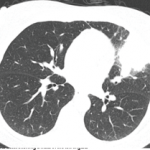A short while later, a call from the radiologist confirmed my fears. Maria’s chest X-ray had demonstrated a large, irregular mass in her right upper lobe that was partially collapsing the lung. Maria had lung cancer.
Les Doigts Hippocratiques
Some medical historians consider clubbing to be the oldest sign in medicine. Nearly 2,500 years ago, Hippocrates astutely recognized that digital clubbing was a sinister sign of illness in the chest, vividly describing that, “if you put your ear against the chest you can hear it [pus] seethe inside like sour wine.”1
Although the link between clubbing and lung disease remains undisputed, the underpinnings of this relationship have remained obscure. The first clue came from the work of the prolific French neurologist, Pierre Marie, MD, and the Austrian internist, Eugen von Bamberger, MD, who, working separately, described the degree of bone proliferation and periosteal involvement seen in clubbing, leading Dr. Marie to rename the condition, pulmonary hypertrophic osteoarthropathy.
A second clue arrived 40 years later with the publication of a small series of British patients with clubbing. Several of them were initially thought to have RA, but were found instead to have a pulmonary malignancy without evidence for empyema, tuberculosis or lung abscesses, which had been the most commonly observed findings in patients with clubbing.2
For a while, humoral factors and excessive vagal nerve stimulation (vagotomy helped lessen the hand pain in a few patients) were considered to be the prime mediators of clubbing, but neither of these vague explanations was intellectually satisfying. About 30 years ago, it was proposed that an accumulation of megakaryocyte fragments or platelet aggregates that bypassed the lung capillary network in various cardiac and pulmonary diseases could increase finger vascularity and permeability and promote mesenchymal cell growth to produce periosteal new bone formation and clubbing via the release of platelet-derived growth factor (PDGF) from the small vessels of the fingertips.3 Subsequent research identified vascular endothelial growth factor (VEGF) as the likely critical cytokine in the pathogenesis of the periostitis in clubbing.4
Another pivotal observation was the identification of a specific genetic mutation of a prostaglandin transporter enzyme in many patients afflicted with the familial form of hypertrophic osteoarthropathy, which markedly elevated their levels of circulating prostaglandin E2 (PGE2). PGE2 is a potent stimulator of VEGF-mediated osteoblast activation and bone formation and its striking concentration in certain individuals with clubbing may obviate their need to have a chest full of “seething pus.”


